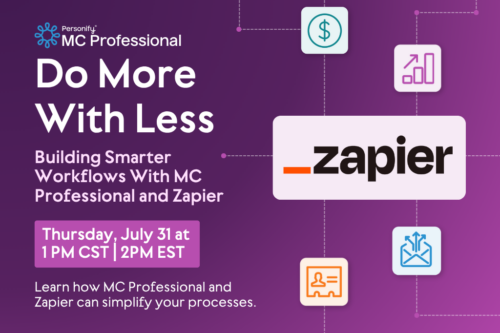Conferences are an amazing way to learn new skills, hear stories for other people in your industry and to meet new people. About 1 in 4 Americans work from home and the appeal of participating in events from home is more appealing than ever.
But what is a hybrid event? Why would you host one? And how would you host one? We’re diving into all the questions you have about hybrid conferences and events, so read on to learn more!
What is a hybrid event?
A hybrid event means that is a mix of in-person and virtual components. You could have sessions live streamed or have sessions that are offered online or in person, or a mix of it all together. Mixing both physical and virtual sessions, events, speakers, engagement opportunities and everything else in between can build a unique experience for vendors, speakers and attendees.
What events can be hybrid?
You can take a hybrid approach to all types of events, including:
- Hybrid meetings for committees, boards, etc
- Networking events
- Nunch and learns
- Lectures
- Professional development events
- Trade events
- Fundraising
- Anything else you can think of!
Benefits of hybrid events
Successful hybrid events give people the opportunity to join events in person while also being welcoming to those who need to — or prefer to — attend from home. Some benefits to hybrid events include:
- Broader audiences around the world
- More variety in guest speakers and call-in speakers
- Increased accessible and welcoming
- Affordable to attend from home for many people
We’ll dive deeper into benefits below.
According to recent research, more than a third (34%) of organizers forecast they’ll invest more in hybrid events in the next few years and 25% of the surveyed organizers plan to host 5-10 hybrid events annually.
Mixing & matching event agendas
While all hybrid events include both in-person and virtual elements, they may not always be inclusive of the same events.
Some organizations want the online event to mirror live events, where all the in-person networking and speaker sessions are streamed online.
But for others, the structure of the virtual and in-person elements have key differences. For example, online attendees are able to view some of the live speaker sessions and panels and also have access to online-only breakout rooms for networking.
The best way to organize your hybrid event
There is no “best way” to organize or break out your hybrid event. There is only a best way for you and your members. Consider polling your members and asking them what they’d prefer if possible. Don’t be afraid to break away from any templates you find online and do what works best for you.
Benefits of Hybrid Events
Cost effective & budget friendly option
Hosting large events can be expensive. If you want to earn more in registration but don’t want to pay for a much larger venue, hosting an online option for your event can boost ticket sales without burning budget. Plus, you can sell online as and sponsorship space for added revenue.
Engaging with a wider audience
H conferences allow more people to attend, regardless of their location or physical ability. If you record keynotes and speaker sessions for attendees to view anytime, you can also engage with audiences across time zones. This flexibility allows you to connect with a broad audience who work in your industry or share common interests.
Repurposing conference content for ongoing learning
Your members and fans can continue to get value from the topics covered at your event long after it’s over. The majority of organizers (86%) continue to see a return on their investment in their hybrid event for seven months after it ended. You can extend your ROI by taking your content presented at your event and turning it into a valuable course in your learning management system.
Promote your organization as a leader in tech
While traditional conferences are great, a hybrid event mixes things up for both you and your members. Hybrid conferences allow organizations to connect with their members in a unique way that also broadens their reach. For example, for 47% of organizers, it’s already become an innovative way to connect audiences dispersed across the globe.
3 Essential Tools for Organizing a Hybrid Conference
To plan, promote, and host a successful hybrid conference, you’ll need the right tools to help you get it all done. While there are plenty of event management solutions at your disposal, we recommend prioritizing the three tools that fall into these categories:
1. Virtual event or hybrid event platforms or software
First and foremost, you’ll need virtual event software that allows you to share your conference online. Choose a solution that not only makes it easy to set up and share a virtual event, but that’s also simple to use to create one-day or multi-day events and livestream your entire conference.
2. Membership management software
Save time and additional hassle by inviting and registering your members right from your own membership management platform. You can also collect post-event feedback from attendees and review reports on the success of your event. Choose a tool that integrates with and/or includes both a virtual event platform and marketing software (like MemberClicks!)

3. Marketing tools
A comprehensive marketing platform can help you create and deploy a holistic marketing strategy for your hybrid event. Email event reminders to registrants, share details of your event to your branded social channels, and include info about your event right on your association website.
Hybrid event planning: 11 steps
Because hybrid conferences combine the best parts of virtual events with more traditional, in-person events, it comes with unique advantages.
Now you know the tools you need, it’s time to get your strategies and planning into place. To help you get started, we’ve rounded up 10 tactical tips to help you execute an effective hybrid event from start to finish.
1. Define your goals
When you begin to plan your hybrid conference, it’s helpful to set some objectives to guide your efforts and to keep you accountable. According to a recent study, 76% of people who wrote down goals and sent weekly progress reports to an accountability buddy met their objectives.
Determine what success will look like for your event. Success could be about:
- Registering a set number of attendees
- Recruiting new members
- Earning more revenue
- Connecting with new sponsors
Whatever the motivation, we recommend sitting down with your other event organizers to create a set of SMART goals around agreed success metrics.
2. Choose your tools
We already explored what tools you need. Now it’s time to pick what tools will work for you. Select and vet an event management platform to host and promote your hybrid conference. When choosing a platform, find software that allows you to register attendees, check them in on-site and is designed with membership organizations in mind.
3. Get the details under wraps
Time to get the technical pieces out of the way. Sit down with your planners and determine:
- Date
- Time
- Budget
- Venue (once your date is set)
- Branding colors
- Theme
- Title
All of these should reflect your goals and vision for your event. Once these details are done, you can move onto the FUN stuff!
4. Identify your target audience and send personalized invitations
Who should attend your event? Do you want established members of your association to attend? Or maybe past event attendees. Are you opening registration up so you can land new members?
Whatever you want to do, decide it early. Then, establish a profile of your ideal attendee that covers these kinds of characteristics.
Next, dive into your member CRM and segment out the people who match your profile. Take your list and create personalized invitations asking them to join you at your event either in-person, online or both. In your email invite, include all your event details, a link to the virtual event and follow-up with instructions on how to log on when it’s time.
If you’re opening up registration to non-members, you can post on social media, share with your partners, or encourage your members to invite others as well.
5. Optimize both sides of the experience
It can be a challenge to ensure both online and in-person attendees have a similar experience at your event. Research showed that about two-thirds (67%) of organizers say that it is challenging to ensure they have the right technology to create a smooth experience. Another 71% said their biggest challenge was connecting in-person and virtual attendees with one another.
While there are plenty of obstacles that can arise while planning a hybrid event, there are a lot of ways to create a more seamless experience for all your attendees.
Our tips are:
- Test out all your software and equipment before the big day.
- Creating checklists so you have everything you need for both the in-person and virtual sides of your conference.
- Reaching out to other organizations that have hosted hybrid conferences and asking for tips and tricks.
- Have a staff member sit in on virtual events to monitor any technical issues or challenges.
Ultimately, if you’re putting in equal care and consideration into both your in-person and virtual audience at your hybrid event, you will be on the right track.
6. Conduct a strategic marketing campaign
To ensure prospective attendees know all the details about how to participate, create a marketing strategy and targeted campaign for your hybrid event.
As part of your campaign, you can promote the details of your event, how to sign up, and all the benefits of attending by:
- Sending emails to members and previous event attendees
- Posting on your branded social channels
- Sharing event details on your organization’s website
- Including information in your regular newsletter
- Getting speakers/prominent attendees to share details with their social networks
7. Encourage participation throughout the event
Sitting in speaker session after speaker session can cause any attendees’ eyes to glaze over. Don’t force attendees to sit for hours in uncomfortable chairs (or stare at a screen) without any breaks or further interaction.
To keep both online and in-person audiences engaged, mix in question-and-answer sessions, speaker panels that interact with the audiences, live polls, and breakout sessions.
8. Test run your event
To make sure you feel prepared for the big day, host a dry run of your hybrid conference. A few days before your event, get together with your organizers and walk through all aspects of both the virtual and in-person events, like trying to register online and logging in as a virtual attendee or testing the equipment you’ll need for the live portions of the event.
Doing a test run this way can help you and your team identify any issues and tackle them before the big day—that way, you won’t be scrambling to correct any problems on the day of.
9. Equip your speakers with the right tools and resources
Don’t forget to set your speakers up for success! Whether they’re presenting to your live audience or engaging online with your virtual attendees, make sure they have everything they need for the day of the event.
For live speakers, have a microphone, speakers, and a wireless presenter ready for them to change slides as they go. For virtual speakers, set them all with all the appropriate technology. Let them know how to log into the appropriate platform and interact with virtual attendees.
The more comfortable and prepared your speakers are, the better their presentations—and ultimately, that means your attendees will get more ROI out of your event.
10. Store conference content using your learning management system
Once your event is over, your conference content doesn’t have to stay stored in a digital archive. Instead, take those learnings and lessons and make them available beyond your event as ongoing education modules.
Compile all your event content and upload it into your learning management system. From there, you can make it available for free to your members or you can charge a fee to create a new revenue stream.
11. Follow up with event attendees
Your work isn’t done when your event is over. Once your hybrid conference is in the rearview mirror, host a post-mortem of your event. Review the successes and areas of improvement and take this opportunity to follow up with attendees to get their feedback. You can then incorporate that feedback into future events.
Organizing a Hybrid Conference: Taking the Next Steps
Now that you know the ins and outs of what makes hybrid events unique and you’re equipped with some high-impact strategies, it’s time to move forward with your own hybrid conference.
Need some additional guidance to get you started? Learn more about planning association events with our roundup of important questions to ask your members.
















